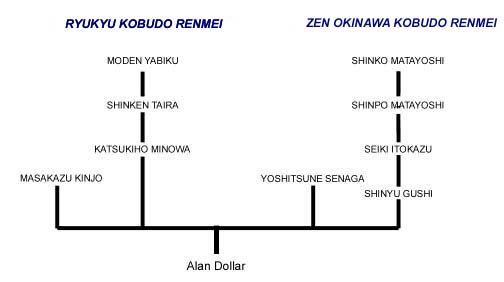

|
|
SHINKEN TAIRAShinken Taira (1897-1970) learned
karate in Japan from Gichin Funakoshi and Kenwa Mabuni.
Kobudo instruction came from Moden Yabiku. Taira began
teaching kobu-jutsu in Okinawa about 1940. He is remembered
for bridging the gap between karate and kobudo by applying
weapons movements to karate techniques.
|
|
The Taira family name was Maezato.
All the Maezato kata were created by Shinken Taira. Shinken
Taira founded the Ryukyu Kobudo Hozon Shinko Kai, the
Society for the Promotion and Preservation of Ryukyuan
Kobudo.
Before his death in 1970, he named Eisuke Akamine the successor to his system. Sensei Akamine, who began training under Shinken Taira in 1959, supports the theory that weapons were developed from farming tools. He reorganized the association into the present day Ryukyu Kobudo Renmei. |
|
|
|
|
 |
KATSUKIHO MINOWA A prominent student of Shinken Taira is Katsukiho Minowa of the Uechi ryu karate system. Sensei Dollar began the study of kobudo under Sensei Minowa in 1975, after receiving his Shodan in Uechi ryu karate from Kanei Uechi. |
|
The Sai |
The Teko |
 |
Sensei Minowa's most prominent student is Masakazu Kinjo, an outstanding weapons expert and historian. He holds the rank of seventh dan in Uechi ryu and Okinawan kobudo. The tenacious dedication and ability of Masakazu Kinjo and his oldest son Satoshi give promise to a continued strong line of Okinawan kobudo for future generations. |
|
His Uechi ryu/kobudo dojo and the
Ryukyu Kobudo Hozonkai headquarters are located in Kubagawa,
Okinawa.
|
|
|
|
|
 |
Sensei Shinko Matayoshi made changes
to the position of the bo when striking, one fundamental
departure from the past. Under Taira's
system the back hand holding the bo is locked at the side of
the body near the belt when striking. Matayoshi felt that
new students to kobudo lacked the proficiency to chamber
accurately in this position. Newer students repeatedly hit
themselves in the body, particularly the spleen, with the
back portion of the bo. This caused many injuries and
illnesses.
|
|
Shinpo Matayoshi (1921-1997) learned
kobu-jutsu from his father. He also trained under Chotoku
Kyan in Kadena village. He later learned White Crane from
Gokenki, a close friend of Kanbun Uechi. Shinpo Matayoshi
reportedly trained briefly with Shinken
Taira.
|
|
YOSHITSUNE SENAGAAmong Sensei
Matayoshi's students was Yoshitsune Senaga, currently an
eight dan in Uechi ryu and Okinawan kobudo. His grandfather
was taught bo techniques by Sensei Akamine, who created the
kata Seijun no bo, in the late 1800's. This kata, also
taught by Shinyu Gushi, is not well
known. Akamine kept his karate and kobudo instruction very
secret in the small village of Uebara, where his family name
was Seijun. Sensei Senaga's karate and kobudo dojo is
located in Nakagusuku.
|
|

an Eku kata at Golden Gate 98 |
SHINYU GUSHISeiki Itokazu passed his kobudo
teachings on to Shinyu Gushi of Uechi-ryu. Sensei Gushi is
the highest-ranking Okinawan Uechi ryu practitioner living
in the western world. He holds the ranks of eighth dan in
Uechi ryu karate and seventh dan in Okinawan kobudo. He
currently resides and teaches at the headquarters of the
Ryu-ko-ka-ku-ken Karate Kobudo Association in California.
|
|
Alan DollarAfter passing a four-hour workout
and examination in the use and application of traditional
karate weapons, Sensei Alan Dollar became the first
Godan (5th degree black belt) and the first
Shihan (master Instructor) promoted by Master
Shinyu Gushi's Okinawan Ryukokaku Ken
Association.
|
|

|
|